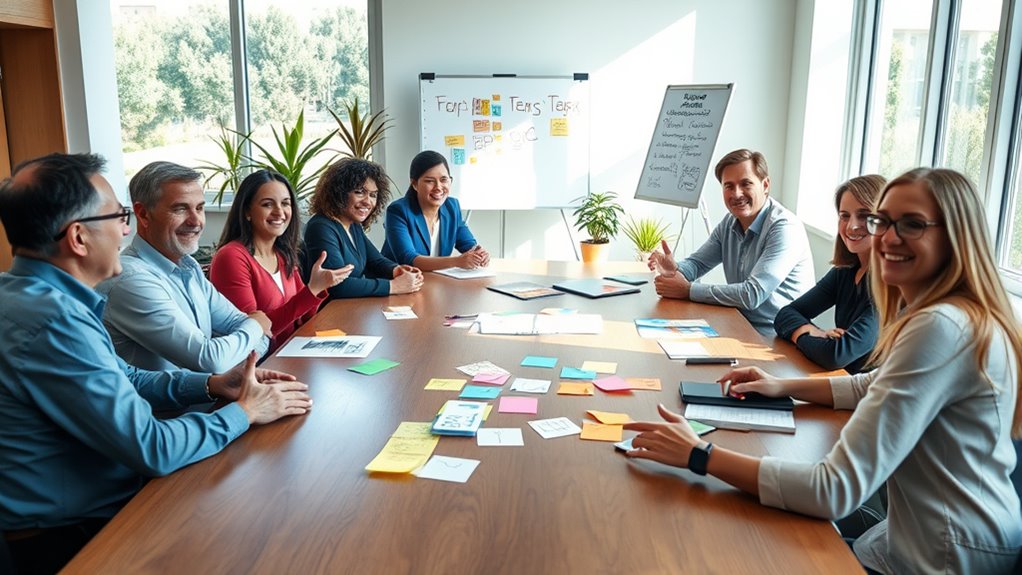Mindful communication with faculty and staff fosters collaboration by creating a supportive and engaged environment. When you practice active listening and intentional speaking, you enhance trust and understanding in your interactions. This approach minimizes distractions and encourages empathy, ultimately strengthening relationships. By incorporating mindfulness tools and exercises, you can further improve teamwork dynamics. Keep exploring to discover more techniques that can elevate your communication and collaboration efforts.
Key Takeaways
- Mindful communication enhances active listening, fostering understanding and collaboration among faculty and staff.
- Establishing clear goals encourages diverse perspectives and aligns team efforts, strengthening collaboration.
- Regular mindfulness training cultivates effective communication and nurtures positive work environments.
- Open dialogue and honest conversations build trust, essential for successful collaboration and teamwork.
- Utilizing tools like CoffeePals and Mindful Spaces promotes informal interactions, enhancing connections and collaborative efforts.
What Is Mindful Communication?

Mindful communication is all about being fully present and engaged in your interactions. It involves applying mindfulness by setting intentions, remaining open, and showing compassion in every conversation.
By practicing active listening, you give your full attention to the speaker, which fosters deeper understanding and connection. This approach not only enhances your emotional intelligence but also supports clarity and conciseness in self-expression. Consequently, you build trust among team members, creating a foundation for effective collaboration.
When you integrate mindfulness into your communication, you cultivate a positive and supportive environment, allowing everyone to feel heard and valued. Ultimately, mindful communication transforms your workplace relationships, paving the way for a more cohesive and productive team dynamic.
The Importance of Collaboration in Education

Collaboration is key to enhancing teamwork dynamics and building trusting relationships among faculty and staff.
When you work together, you not only boost productivity but also create a supportive environment that fosters mutual respect. High cultural intelligence (CQ) can significantly enhance collaboration by helping individuals understand and appreciate diverse perspectives. Engaging in nighttime meditation can further improve focus and communication, thereby strengthening collaborative efforts. This foundation of trust can lead to better outcomes for both educators and students. Additionally, fostering a culture of innovation and collaboration can significantly enhance the overall educational experience. To achieve this, it is essential to establish clear goals that align with the diverse needs and strengths of all team members.
Enhancing Teamwork Dynamics
Mindful collaboration plays a crucial role in this process, as it encourages effective communication and active listening among faculty and staff. By prioritizing these practices, you contribute to a positive work environment that nurtures employee engagement and boosts morale. When everyone feels heard and valued, teamwork dynamics improve, leading to a more cohesive and motivated team. Regular mindfulness training and collaboration workshops can reinforce these principles, allowing educators to break down barriers and build strong connections. Additionally, staying focused on collaborative goals enhances relationships and encourages teamwork in education. Ultimately, these efforts lead to improved student outcomes and a thriving educational community where everyone collaborates effectively. Incorporating playful communication techniques, such as texting humor, can further enhance team bonding and ease workplace tensions. Understanding the impact of social connections is essential in fostering a supportive atmosphere that promotes collaboration among staff.
Building Trusting Relationships
Trust is the foundation of any successful educational environment, and building trusting relationships among faculty and staff is essential for fostering effective collaboration.
By engaging in mindful listening, you can develop stronger communication skills that enhance understanding and create positive relationships. When you focus on collaboration, you not only boost trust but also contribute to a cohesive school culture. Additionally, just as vape juice has a shelf life that requires mindful storage, nurturing these relationships demands ongoing effort and care. It is crucial to prioritize open dialogue to address any concerns that may arise and reinforce these connections. Just as unconditional love between a father and daughter fosters emotional safety, creating a secure atmosphere among staff encourages honest communication.
Intentional opportunities for team-building and open dialogue can greatly improve emotional engagement, leading to higher job satisfaction and performance. Additionally, fostering trust among educators helps improve student outcomes and drives overall institutional performance, similar to how new Bitcoin holders have influenced market dynamics.
Remember, fostering trust among educators helps improve student outcomes and drives overall institutional performance.
Prioritize these connections, and you’ll cultivate an environment where collaboration thrives, benefiting everyone involved in the educational process.
Key Principles of Mindful Communication

Mindful communication hinges on several key principles that can greatly enhance your interactions with faculty and staff.
By incorporating these elements, you can foster a more collaborative environment focused on understanding:
- Set Intention: Begin conversations with a clear purpose, guiding your communication towards meaningful outcomes. Engaging in effective relaxation techniques can help you maintain focus and clarity during discussions. Additionally, adopting a proactive mindset can lead to more productive exchanges. Understanding the importance of self-care practices can also improve your overall communication effectiveness.
- Practice Active Listening: Give your full attention to the speaker, minimizing distractions to guarantee you’re fully engaged in the present moment.
- Embrace Compassion: Approach discussions with an open and non-judgmental mindset, demonstrating empathy to strengthen relationships. Additionally, recognizing communication breakdowns can be crucial to fostering healthier interactions and preventing misunderstandings.
Mindful Listening Techniques

To truly connect with your colleagues, you need to practice active listening techniques that enhance your focus and understanding. This means overcoming common barriers that can hinder your ability to fully engage with what others are saying. Additionally, developing a budget plan can help manage distractions and prioritize your time effectively during conversations. Incorporating positive thinking into your interactions can further enhance collaboration and understanding among team members. Furthermore, embracing mindfulness practices can reduce the likelihood of small errors in communication, fostering a more productive dialogue. Engaging in self-discovery through mindful communication can deepen relationships and encourage collaborative growth.
Active Listening Practices
Active listening is essential for effective communication, and it requires your full attention to truly engage with the speaker’s message. By honing your active listening skills, you can foster understanding and collaboration in the workplace.
Here are some mindful listening techniques to help you:
- Avoid self-focus and resist the urge to compare thoughts while listening.
- Allow silences for speakers to collect their thoughts and express themselves fully.
- Refrain from interrupting, showing respect and empathy for their message.
Practicing these techniques encourages empathy and compassion, helping you connect with colleagues on a deeper level. Moreover, establishing healthy boundaries during conversations can enhance mutual respect and understanding. Additionally, being aware of emotional alignment can significantly improve the quality of your interactions. In a similar vein, balancing career and personal life is crucial for maintaining effective communication in collaborative environments.
Ultimately, incorporating active listening into your interactions promotes a culture of openness and trust, enhancing overall collaboration and team dynamics.
Overcoming Listening Barriers
While practicing active listening lays the foundation for effective communication, overcoming barriers that hinder your ability to truly hear others is equally important.
Mindful listening requires your full attention, minimizing distractions and avoiding the urge to rehearse your response while others speak. Common roadblocks like comparing thoughts, making judgments, or attempting to read minds can distort your understanding and hinder open communication.
To enhance your mindful listening, allow pauses for silence, giving speakers time to reflect. Engage fully by paraphrasing their message and asking clarifying questions when needed.
Cultivating an attitude of openness and non-judgment during interactions fosters collaboration and strengthens relationships among faculty and staff, enhancing overall communication dynamics.
Mindful Speaking Strategies

Mindful speaking strategies can transform your interactions with faculty and staff, ensuring that your message is clear and engaging. By incorporating mindfulness practices into your communication, you foster trust and collaboration.
Here are three key strategies to enhance your speaking:
- Be concise and direct: Respect others’ time by getting to the point while being specific in your message.
- Use examples: Clarifying your ideas with relatable examples boosts engagement and understanding.
- Stay on topic: Observe your audience’s responses to maintain focus and relevance in discussions.
Practicing these strategies not only promotes clear communication but also encourages active listening, ultimately building stronger relationships and collaborative environments.
Building Trust Through Open Dialogue

Open dialogue is essential for building trust among faculty and staff, as it creates a safe environment where everyone feels comfortable sharing their ideas.
By fostering open communication, you deepen trust, which is vital for effective collaboration. Honest conversations allow you to address challenges transparently, leading to improved solutions and a supportive atmosphere.
Fostering open communication deepens trust, essential for collaboration and transparent problem-solving in a supportive atmosphere.
Mindfulness in your interactions enhances understanding, enabling positive emotional exchanges that boost overall well-being. A psychologically safe workplace encourages participation, making faculty and staff more engaged and productive.
To strengthen relationships, implement regular check-ins and reflections, reinforcing a culture of trust.
Ultimately, prioritizing open dialogue cultivates collaboration, ensuring that everyone’s voice is valued and heard in your educational environment.
Fostering Empathy in Interactions

Fostering empathy in your interactions with faculty and staff can greatly enhance collaboration and connection.
By practicing active listening and cultivating emotional awareness, you can build trusting relationships that encourage open communication.
These efforts not only improve team dynamics but also contribute to a positive work environment.
Active Listening Techniques
How can you truly connect with your faculty and staff during conversations? Active listening is key. It involves fully concentrating on the speaker, which fosters empathy and enhances communication.
Here are a few techniques to practice:
- Summarize what they’ve said to show understanding.
- Ask clarifying questions to dive deeper into their perspective.
- Incorporate mindful pauses to allow space for thoughts and feelings.
Cultivating Emotional Awareness
While you engage in conversations with faculty and staff, cultivating emotional awareness can considerably enhance your interactions. By recognizing and understanding your emotions, you foster empathy, which is vital for effective communication.
This emotional awareness creates a non-judgmental environment where everyone feels safe to express their thoughts and feelings, leading to open and honest discussions. Practicing active listening is essential; it helps you engage fully with others’ perspectives, promoting deeper connections and understanding.
Incorporating mindfulness techniques—such as reflection and mindful breathing—can further boost your emotional awareness, enabling you to manage stress and respond thoughtfully.
Ultimately, this approach enhances collaboration, improves problem-solving abilities, and contributes to better organizational outcomes.
Building Trusting Relationships
Emotional awareness lays the groundwork for building trusting relationships with faculty and staff.
When you foster empathy in your interactions, you create an environment ripe for collaboration.
Here are key aspects to contemplate:
- Active Listening: Engaging with your team members promotes understanding and respect.
- Honest Conversations: Open communication deepens trust and accountability.
- Self-Reflection: Being aware of your emotions enhances emotional intelligence.
Incorporating Mindfulness Into Meetings

Incorporating mindfulness into meetings can transform the way you and your colleagues engage with one another. Starting with a brief mindfulness exercise, like mindful breathing, enhances focus and creativity, aligning your attention to the present.
Encourage participants to set positive intentions, fostering a sense of purpose and collaboration. Practicing active listening allows everyone to express their thoughts without interruption, which helps reduce misunderstandings and promotes open communication.
Incorporating mindful movement, such as stretching, refreshes energy levels during long meetings. Additionally, mindful check-ins at the start can help share current states of mind, promoting empathy and strengthening connections.
Tools for Enhancing Mindful Collaboration

Mindful communication goes hand in hand with the right tools that enhance collaboration among faculty and staff. By utilizing these tools, you foster meaningful relationships and improve overall engagement within your team.
Here are three effective tools to contemplate:
- CoffeePals: Facilitate informal interactions that strengthen personal connections.
- Mindful Spaces: Create environments that promote open communication and boost morale.
- Virtual Coffee Chats: Establish regular routines for meaningful engagement outside formal meetings.
These mindful collaboration tools not only encourage emotional engagement but also contribute to a supportive atmosphere.
Practical Exercises for Mindfulness in Communication

Enhancing your communication skills through practical mindfulness exercises can transform interactions among faculty and staff. Mindfulness can help you focus and reduce stress, paving the way for better collaboration. Here are some effective exercises:
| Exercise | Purpose |
|---|---|
| Mindful Breathing | Enhances focus and reduces stress |
| Active Listening | Improves understanding and collaboration |
| Brief Mindfulness Exercise | Fosters presence before discussions |
| Mindful Check-ins | Encourages empathetic interactions |
Frequently Asked Questions
How Do You Foster Collaboration and Communication Within Your Team?
To foster collaboration and communication within your team, create a safe environment where everyone feels comfortable sharing ideas.
Hold regular check-ins to encourage open dialogue and assess dynamics. Use active listening to guarantee all voices are heard, promoting respect and unity.
Start meetings with brief mindfulness exercises to center focus.
Additionally, leverage informal tools like CoffeePals to build personal connections, strengthening teamwork and enhancing collaboration efforts across your team.
What Communication Strategies Have You Experienced in Practice That Foster Interprofessional Collaboration?
You’ve felt the magic of open dialogue, where ideas flow like a gentle stream, nurturing collaboration among diverse voices.
Active listening transforms conversations into vibrant exchanges, fostering trust and understanding.
Regular check-ins act like a warm campfire, inviting everyone to gather and share their thoughts.
When you set positive intentions before meetings, the atmosphere buzzes with energy, encouraging participation.
Casual chats over virtual coffee build camaraderie, turning colleagues into a cohesive team.
What Are Three Ways to Foster Cooperation and Collaboration in the Workplace?
To foster cooperation and collaboration in the workplace, start by encouraging open communication; create a safe space for sharing ideas and feedback.
Next, implement regular team check-ins to discuss goals and challenges, enhancing mutual understanding.
Finally, celebrate team achievements to boost morale and encourage continued teamwork.
What Is Mindful Collaboration?
Think of mindful collaboration as a symphony, where each instrument plays in harmony.
It’s about engaging with your team in a respectful and attentive way, ensuring everyone’s voice is heard. You actively listen and express yourself clearly, creating an environment of trust.
This approach fosters empathy, allowing you to appreciate different perspectives. As you navigate conflicts constructively, you’ll notice improved dynamics and productivity, leading to a more positive and satisfying workplace experience.
Conclusion
In embracing mindful communication, you open the door to deeper collaboration with faculty and staff. By listening patiently, speaking thoughtfully, and fostering empathy, you create a vibrant environment where ideas flourish. Remember, each conversation is a step toward connection, each interaction a chance to grow. So, as you move forward, let mindfulness be your guide, weaving threads of understanding and cooperation into the fabric of your educational community. Together, you can build a stronger, more united future.










